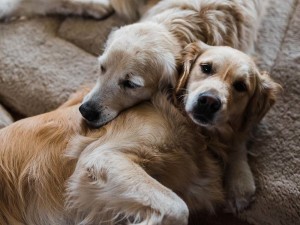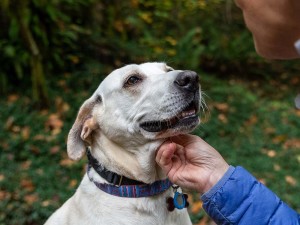What Does Cancer Smell Like? Ask Your Dog
Dogs’ remarkable ability to sniff out disease is opening doors to earlier cancer detection in people.
Cancer. The very word strikes fear in us. A voraciously living thing, cancer is an uncontrolled division of abnormal cells that destroy nearby healthy tissue. Because the natural, life-building process of cell division isn’t perfect, cancer has always been part of the human experience, one that eventually has an impact on everyone — if not directly, then when a relative, friend, or pet is diagnosed with it.
Over the past decade, dogs have been increasingly helping us detect minute, microscopic things we can’t see and certainly can’t smell, like cancer in its earliest stages, when it’s most treatable. Here’s what you need to know about cancer-smelling detection dogs.
Trick question: All dogs are perfect! But find out which type is the best fit for you.
Do diseases really have distinct smells?
Infectious diseases such as cholera, diphtheria, smallpox, pneumonia, tuberculosis, typhoid fever and yellow fever have long been known to produce signature odors. Parents and doctors have used their noses to detect things like strep throat (metallic-smelling breath), phenylketonuria or PKU (in which the baby’s sweat smells like locker-room towels), even schizophrenia (a musty smell).
Mammals evolved using odors to find food, avoid illness-inducing spoiled or poisonous food, detect toxins in the environment, distinguish friends from predators, and assess well being. Following our noses is likely one of the key reasons humans, dogs, and other mammals developed large brains: to process all those smells.
How much do you spend on your pet per year?
Dogs are quite upfront about this smelling stuff, greeting each other with a thorough sniff from tip to tail (or vice versa), and quickly gathering a wealth of information through their noses. Humans do the same thing, just not quite so boldly.
So, how can dogs smell cancer?
Historically, we’ve taken advantage of dogs’ superior sense of smell to track people and animals and to detect drugs, bombs, chemicals, and even stress. So what exactly are dogs picking up with their remarkable olfactory sense? Turns out, it’s volatile organic compounds, or VOCs.
What are VOCs?
Simply put, VOCs are chemicals coming from a living or once-living organism that can pass into the surrounding air (“volatile” in this case means easily evaporated at normal temperatures). VOCs, which can be natural or human-made, are both numerous and ubiquitous. Our bodies constantly emit an incredible array of VOCs, some of which are odorous and some of which are not.
VOCs are first secreted at the cell level, finding their way into our blood, breath, skin, sweat, urine and feces and from there into the air, rather like the dead skin cells (dander) we slough off on a daily basis. VOCs vary depending on the individual’s age, gender, diet and health, and possibly even genetic background. Just as our fingerprints and irises are uniquely individual, so is our fragrance.
Dogs have a better sense of smell.
Illness resulting from infectious diseases and metabolic disorders, including cancer, influence and change our VOCs — our odor profile. While we may or may not smell the change, dogs certainly can. The average dog has a sense of smell that is between 10,000 to 100,000 times keener than the average human’s, and the part of the dog’s brain that analyzes smell is proportionally 40 times greater than ours. This allows them to detect specific odors, including specific VOCs, in parts per trillion. One scientist described this as being able to detect one rotten apple in a barrel of two million.
Dogs often display intense interest in a new cut on their person’s leg or arm, putting their nose close to the wound and sniffing with purpose several times. When they do this, they’re inhaling the VOCs put out by the body’s blood and changing skin cells as they waft into the air.
What do dogs do when they smell cancer?
It’s not a stretch to understand how, using dogs’ built-in and potentially life-saving ability, individual dogs can be trained to detect and alert to specific VOCs associated with a wide variety of conditions in a more general way.
Cancer has been the most recent focus of this sort of research. The earlier cancer is detected, the better the patient’s chances are for survival. Dogs can detect certain cancers with high levels of accuracy long before some of the more traditional diagnostic methods. The trick is identifying the signature VOC that relates to a specific type of cancer so that the dog can be trained to alert to it by giving their handler a signal.
Dogs are key to battling this condition.
Researchers are making great progress. Dogs have been trained to detect ovarian cancer in blood samples, distinguishing it from other gynecological cancers and healthy control samples. They have also been trained to detect melanoma, bladder, colorectal and lung cancer in patients’ urine, tumor, or breath samples. It’s not yet clear whether the dogs are detecting VOCs from the cancer cells or from other metabolic processes often seen in patients with cancer.
High accuracy rates
Italian researchers were able to train two German Shepherds, Liu and Zoey, to sniff out VOCs associated with prostate cancer in urine samples with 98 percent accuracy. The study’s remarkable results — far better than those achieved with standard PSA tests — were based on samples from 362 men with prostate cancer and 540 men with either non-neoplastic prostate disease or non-prostatic tumors. Liu and Zoey could tell the difference.*
Using chemical analysis techniques such as gas chromatography and mass spectrometry, researchers are regularly adding VOCs to the list of components known to be associated with specific cancers, infectious diseases, and metabolic disorders. This work is opening doors not just to improvements in the art of diagnosis but also to the understanding of disease processes, which leads to better treatment, novel therapies, or perhaps prevention.
Artificial sniffers
Scientists are also reverse-engineering the dog nose to come up with electronic or artificial sniffers to detect those same VOCs, enhancing doctors’ ability to quickly and definitively diagnose various diseases and conditions in a simple, non-invasive way without using a dog.
Before long, physicians may be waving an electronic nose over our bodies to diagnose illness, as Dr. McCoy did with Captain Kirk and Spock on Star Trek. If so, we’ll have our dogs’ wet, cold, and very keen noses to thank.
*Lead researcher Gianluigi Taverna, MD, chief of the prostatic disease unit at Humanitas Research Hospital in Milan, presented these results in May 2014 at the annual scientific meeting of the American Urological Association and referred to the highly trained dogs as “Ferraris.”








